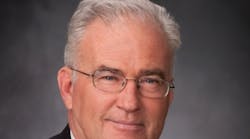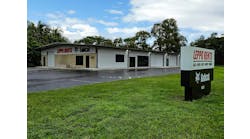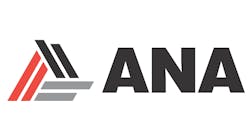Interview with Mig Dobre: Construction Stabilization and Positive Indicators
RER talks with Mircea “Mig” Dobre, senior analyst at Robert W. Baird & Co., about why rental looks better in 2017, likely trends in infrastructure, residential and nonresidential spending, and more.
RER: During the last quarterly survey Baird did with RER, rental revenue was doing pretty well. What do you think the prospects are for rental revenue going forward into next year?
Dobre: Things are feeling a little bit better. I’m going to be really interested in what our respondents say in our next iteration of the survey, which will be post-election. A lot of them are contemplating what this significant change -- because you can’t qualify it as anything else -- really means for their businesses. Even prior to the election we were starting to see some hints of stabilization in the rental market because one of the big problems has been the impact from low oil-and-gas-related activity and that impact has started to lessen. As we head into 2017, we are going to probably see some stabilization, and the driver for the rental business returning to traditional construction and construction-related activity. I’m not talking about the specialty portion of the business, I’m simply talking about the stuff that I know best, construction and construction equipment.
So things are feeling better because of oil and gas. Higher oil prices especially after the OPEC deal, and the recovery in rig counts that we’ve already seen are both good positive indicators. What we’re hoping to see is crude prices continuing on the recovery path, and a little broader activity in terms of oil and gas exploration. The rigs that have been added have really been in a pretty narrow subset, mostly in the Permian Basin. So if we start to see more basins coming back we’ll see the rental industry as a whole, rather than in just one region, starting to feel as if demand is picking up some. So as we look into 2017 for the industry, we are definitely feeling hopeful.
What are your expectations for infrastructure development under a Trump administration?
It’s a little hard to tell right now because unfortunately Donald Trump has not outlined his stimulus package to the level of detail that Hillary Clinton did prior to the election, so it’s a little tougher to understand what his priorities are. It’s also a bit difficult to understand exactly the mechanism that is going to be used here, because somebody in some form has to pay for this. Will this be just true old-fashioned debt-based stimulus spending, or will there be some sort of a private-public partnership system developed, whether it’s an infrastructure bank or some other form? The devil is in the details here. It’s not just a matter of fiscal responsibility but it’s also a matter of timing. Setting up public/private partnerships, in theory, is a lengthier and more complicated process; a lot more steps are involved as opposed to simply using already established federal channels to fund projects.
What would you like to see the focus be: road construction, bridge work, transportation projects? What would be most efficient?
What’s most efficient is not always the most visible, right? In some of the work we’ve done around this, trying to evaluate where the needs are greatest, it certainly appears bridges do need a lot of help and there are tens of thousands of bridges across the U.S. that are in serious need of repair, so certainly that needs to be addressed. I also think water infrastructure is important, and remember we haven’t had a true push for water infrastructure since the early 1970s. That might be a very important avenue.
Then you’ve got basic investment in education and I mean rehabilitating K-12 schools where if you look at spending over the last few years that lagged, and certainly that’s an investment we would make in hopefully a better trained workforce and a more productive workforce in the future. Not to say that roads aren’t important, I certainly believe that to be the case and we all know that there’s a lot of need for investment there as well. I’m happy at least we have a five-year highway bill, so to some extent we’re getting some investment there.
What are some of the trends you see coming up in non-residential construction?
I’ll keep my comments relatively general here, but if you look at what happened in 2016, there was real concern that developed especially in the back half of the year that a non-residential slowdown was imminent. And looking at the reported data from the U.S. Department of Commerce construction put in place, you certainly see in the data that non-residential construction has slowed. We think this is temporary and this is independent of a Trump stimulus, because the leading indicators for non-residential construction are pointing to better times ahead. And I’m not just talking about Dodge momentum or the ABI. I’m talking about construction contracts that had been declining towards the end of 2015 and the first half of 2016, but now have stabilized and we’ve seen better numbers in the last few months. And that gives us comfort that activity is indeed rebounding and as we look into next year we’re probably going to start slow on non-residential construction, but I think that activity is going to pick up in the back half of the year and again this is notwithstanding a stimulus or anything else coming out of Washington.
What about residential?
On the residential side it’s slightly more complicated because this year we have seen a tale of two worlds. This has kind of been the story for the last few years with multifamily and single-family diverging. Multifamily has been really strong for the last two to three years, reaching levels we haven’t seen in decades. As you probably know, that market has slowed significantly. In our view it probably remains slow as we go into ’17. Some of the metropolitan areas that have seen a lot of multifamily starts, the big cities on the coasts, are dealing with excess supply and eroding rents. So that sort of goes to explain the slowdown in activity in multifamily and we doubt that we’re going to see a sharp snap back in the near term.
On the single family front, demand for single family homes is there. However, if you look at household formation, clearly there is a tailwind that’s going to be with us into ‘17 and beyond -- the real problem or issue is the availability of financing. I’m not only talking about lower-credit households or more heavily indebted households being able to access credit, that’s been a problem throughout this cycle, but the fact that interest rates are coming up and coming up rapidly, especially since the election, a factor that everyone has to monitor. What we have seen in not that distant of a past in 2013, is that rapid rising interest rates usually cools off the housing market, particularly the single-family housing market. This is something that we’re monitoring pretty closely. But it’s a bit of a concern for us on housing into next year.
Do you see any positive developments in manufacturing-related construction?
Manufacturing is such a broad category, it contains a lot. In some cases you’ve got oil-and-gas related projects, especially downstream. Every one of these projects, in and of itself, is quite large. So as those are being completed they create difficult comparisons. If you’re talking about fundamental investment in manufacturing, we really don’t see a catalyst for growth here; and there’s still a lot of excess capacity out there, and capacity utilization is relatively low. And it’s too early to tell how the changes in Washington are going to drive re-shoring, because that’s basically what we’re talking about here. That might be a discussion for 2018-2019 but we’re not getting a sense that there’s anything imminent here.
Warehouses is an interesting area because you could potentially see good investment there. Everything that we’ve read about the warehouse market remains pretty robust. You can thank Amazon for that.
What about the energy space? Trump seems in favor of stimulating the coal industry, but not renewable energy, which is a direction that has been growing.
In terms of coal, it’s not just politics -- it’s economics. Coal and natural gas are substitutes in power generation. As long as we continue to have inexpensive natural gas, that poses a significant headwind for coal.
You are more bullish on oil and gas?
That’s the area that really seems that it’s got potentially some tailwinds. I’m guessing in 2017, rental industry participants that have exposure to nonresidential construction and to oil and gas are going to be the ones that are probably going to be feeling the best.
So it seems like a good year for rental generally?
It feels that way. It feels like a better year than what we’ve been dealing with in the past couple.








